18.07.2024
Here’s How AI Is Changing NASA’s Mars Rover Science
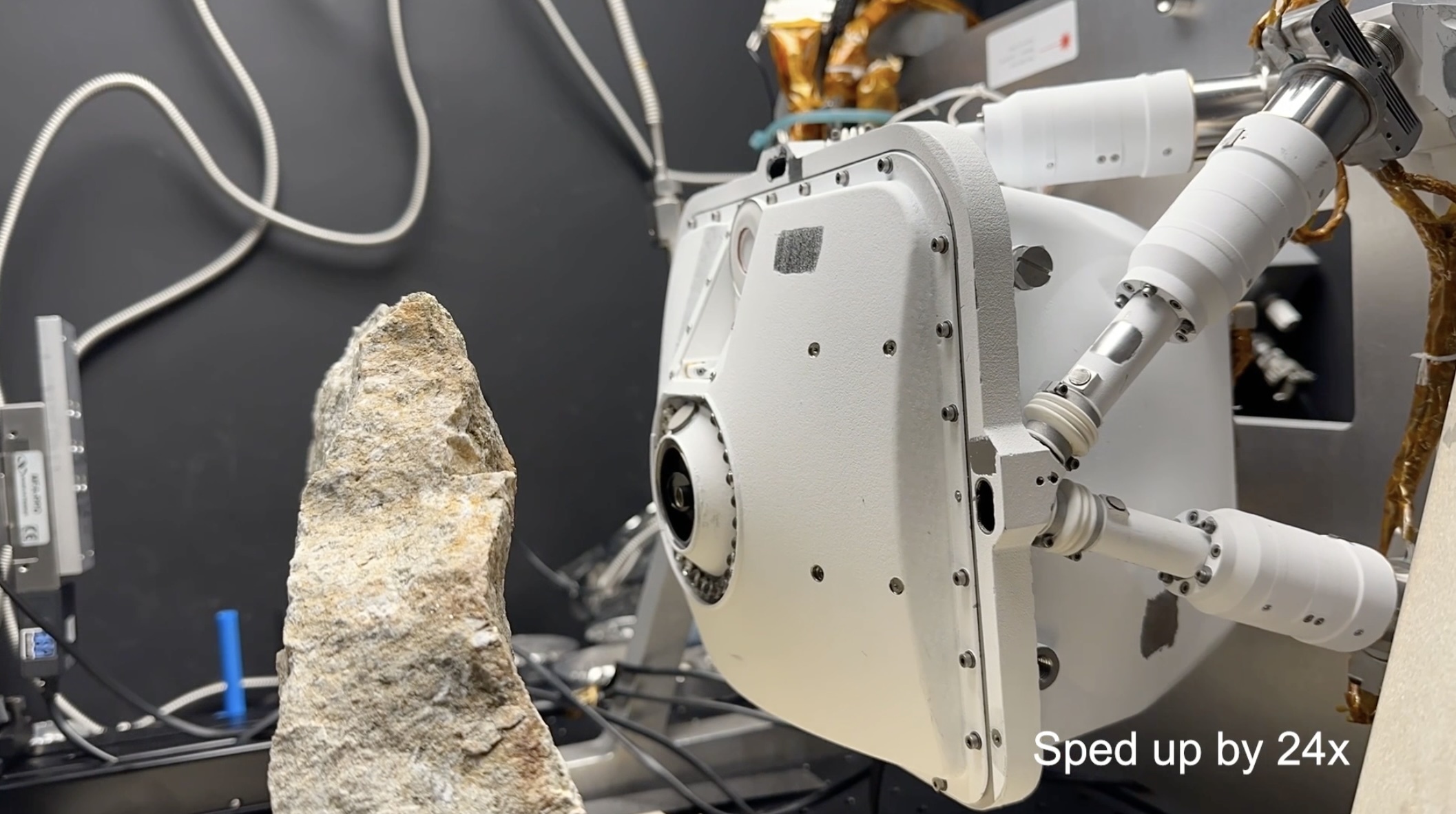
In this time-lapse video of a test conducted at JPL in June 2023, an engineering model of the Planetary Instrument for X-ray Lithochemistry (PIXL) instrument aboard NASA’s Perseverance Mars rover places itself against a rock to collect data. Credit: NASA/JPL-Caltech
Artificial intelligence is helping scientists to identify minerals within rocks studied by the Perseverance rover.
Some scientists dream of exploring planets with “smart” spacecraft that know exactly what data to look for, where to find it, and how to analyze it. Although making that dream a reality will take time, advances made with NASA’s Perseverance Mars rover offer promising steps in that direction.
For almost three years, the rover mission has been testing a form of artificial intelligence that seeks out minerals in the Red Planet’s rocks. This marks the first time AI has been used on Mars to make autonomous decisions based on real-time analysis of rock composition.
The software supports PIXL (Planetary Instrument for X-ray Lithochemistry), a spectrometer developed by NASA’s Jet Propulsion Laboratory in Southern California. By mapping the chemical composition of minerals across a rock’s surface, PIXL allows scientists to determine whether the rock formed in conditions that could have been supportive of microbial life in Mars’ ancient past.
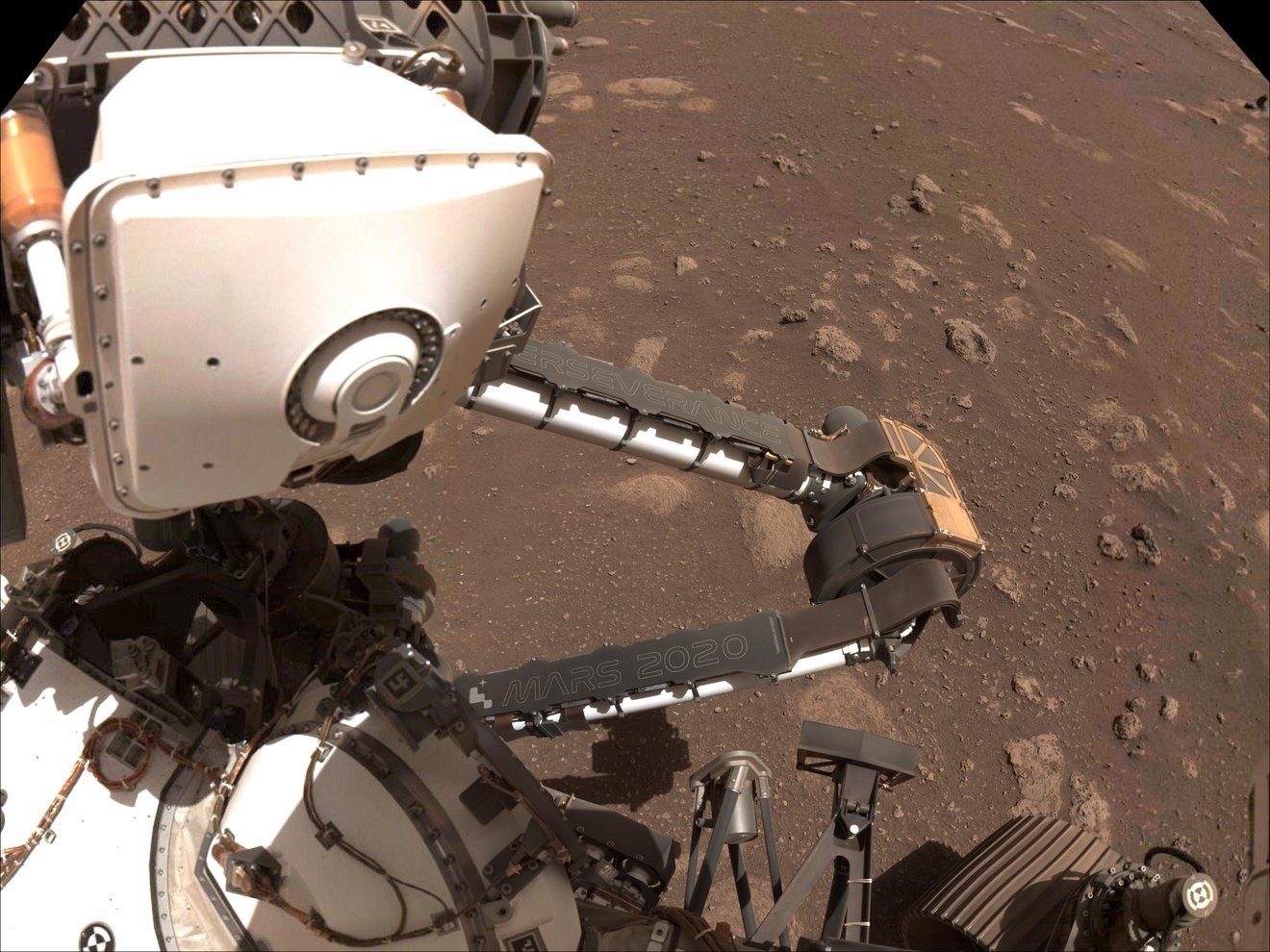
PIXL, the white instrument at top left, is one of several science tools located on the end of the robotic arm aboard NASA’s Perseverance rover. The Mars rover’s left navcam took the images that make up this composite on March 2, 2021. Credit: NASA/JPL-Caltech
Called “adaptive sampling,” the software autonomously positions the instrument close to a rock target, then looks at PIXL’s scans of the target to find minerals worth examining more deeply. It’s all done in real time, without the rover talking to mission controllers back on Earth.
“We use PIXL’s AI to home in on key science,” said the instrument’s principal investigator, Abigail Allwood of JPL. “Without it, you’d see a hint of something interesting in the data and then need to rescan the rock to study it more. This lets PIXL reach a conclusion without humans examining the data.”
Data from Perseverance’s instruments, including PIXL, helps scientists determine when to drill a core of rock and seal it in a titanium metal tube so that it, along with other high-priority samples, could be brought to Earth for further study as part of NASA’s Mars Sample Return campaign.
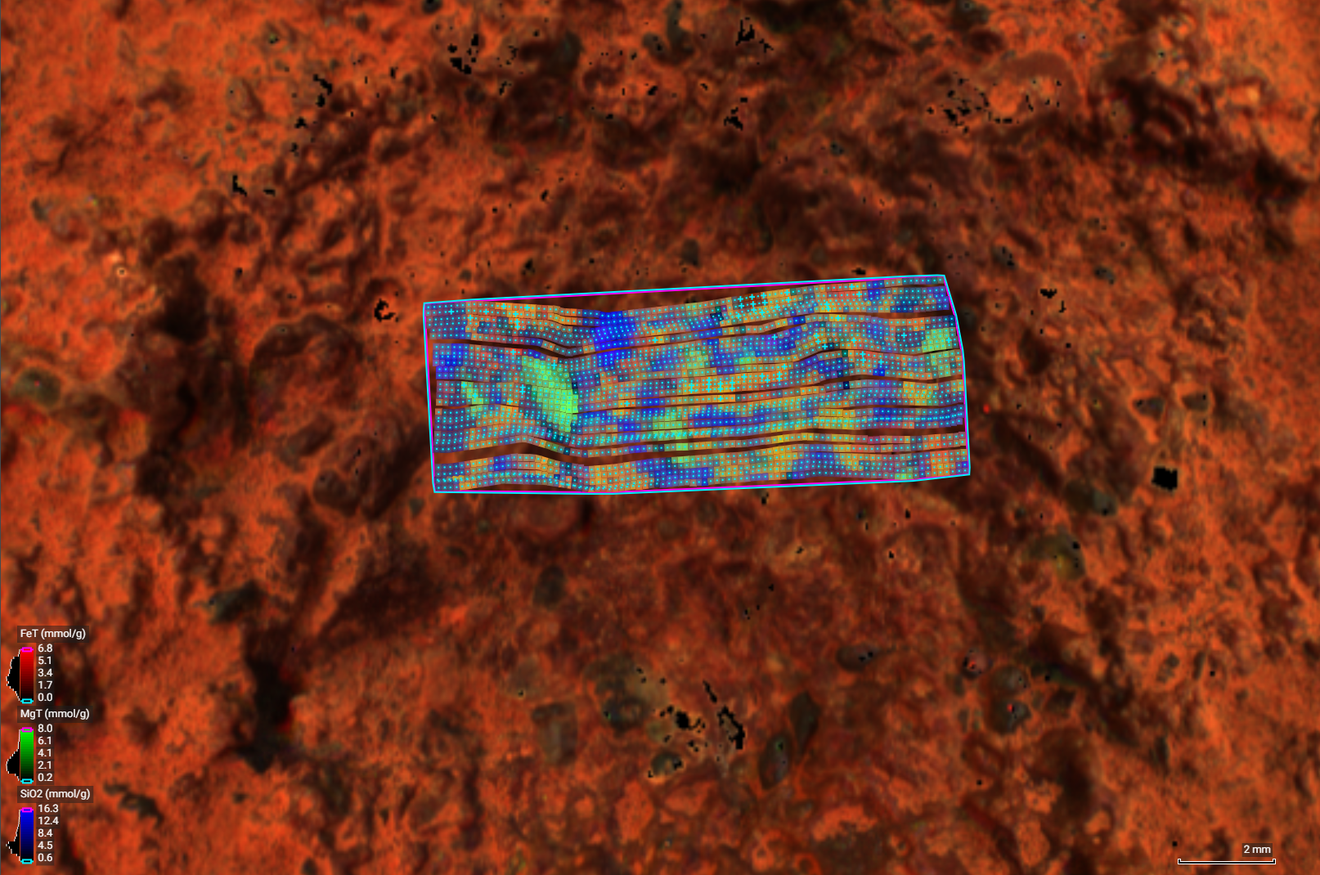
This image of a rock target nicknamed “Thunderbolt Peak” was created by NASA’s Perseverance Mars rover using PIXL, which determines the mineral composition of rocks by zapping them with X-rays. Each blue dot in the image represents a spot where an X-ray hit.
Credit: NASA/JPL-Caltech/DTU/QUT
Adaptive sampling is not the only application of AI on Mars. About 2,300 miles (3,700 kilometers) from Perseverance is NASA’s Curiosity, which pioneered a form of AI that allows the rover to autonomously zap rocks with a laser based on their shape and color. Studying the gas that burns off after each laser zap reveals a rock’s chemical composition. Perseverance features this same ability, as well as a more advanced form of AI that enables it to navigate without specific direction from Earth. Both rovers still rely on dozens of engineers and scientists to plan each day’s set of hundreds of individual commands, but these digital smarts help both missions get more done in less time.
“The idea behind PIXL’s adaptive sampling is to help scientists find the needle within a haystack of data, freeing up time and energy for them to focus on other things,” said Peter Lawson, who led the implementation of adaptive sampling before retiring from JPL. “Ultimately, it helps us gather the best science more quickly.”
Using AI to Position PIXL
AI assists PIXL in two ways. First, it positions the instrument just right once the instrument is in the vicinity of a rock target. Located at the end of Perseverance’s robotic arm, the spectrometer sits on six tiny robotic legs, called a hexapod. PIXL’s camera repeatedly checks the distance between the instrument and a rock target to aid with positioning.
Temperature swings on Mars are large enough that Perseverance’s arm will expand or contract a microscopic amount, which can throw off PIXL’s aim. The hexapod automatically adjusts the instrument to get it exceptionally close without coming into contact with the rock.
“We have to make adjustments on the scale of micrometers to get the accuracy we need,” Allwood said. “It gets close enough to the rock to raise the hairs on the back of an engineer’s neck.”
Making a Mineral Map
Once PIXL is in position, another AI system gets the chance to shine. PIXL scans a postage-stamp-size area of a rock, firing an X-ray beam thousands of times to create a grid of microscopic dots. Each dot reveals information about the chemical composition of the minerals present.
Minerals are crucial to answering key questions about Mars. Depending on the rock, scientists might be on the hunt for carbonates, which hide clues to how water may have formed the rock, or they may be looking for phosphates, which could have provided nutrients for microbes, if any were present in the Martian past.
There’s no way for scientists to know ahead of time which of the hundreds of X-ray zaps will turn up a particular mineral, but when the instrument finds certain minerals, it can automatically stop to gather more data — an action called a “long dwell.” As the system improves through machine learning, the list of minerals on which PIXL can focus with a long dwell is growing.
“PIXL is kind of a Swiss army knife in that it can be configured depending on what the scientists are looking for at a given time,” said JPL’s David Thompson, who helped develop the software. “Mars is a great place to test out AI since we have regular communications each day, giving us a chance to make tweaks along the way.”
When future missions travel deeper into the solar system, they’ll be out of contact longer than missions currently are on Mars. That’s why there is strong interest in developing more autonomy for missions as they rove and conduct science for the benefit of humanity.
Quelle: NASA
----
Update: 27.07.2024
.
NASA’s Perseverance Rover Scientists Find Intriguing Mars Rock
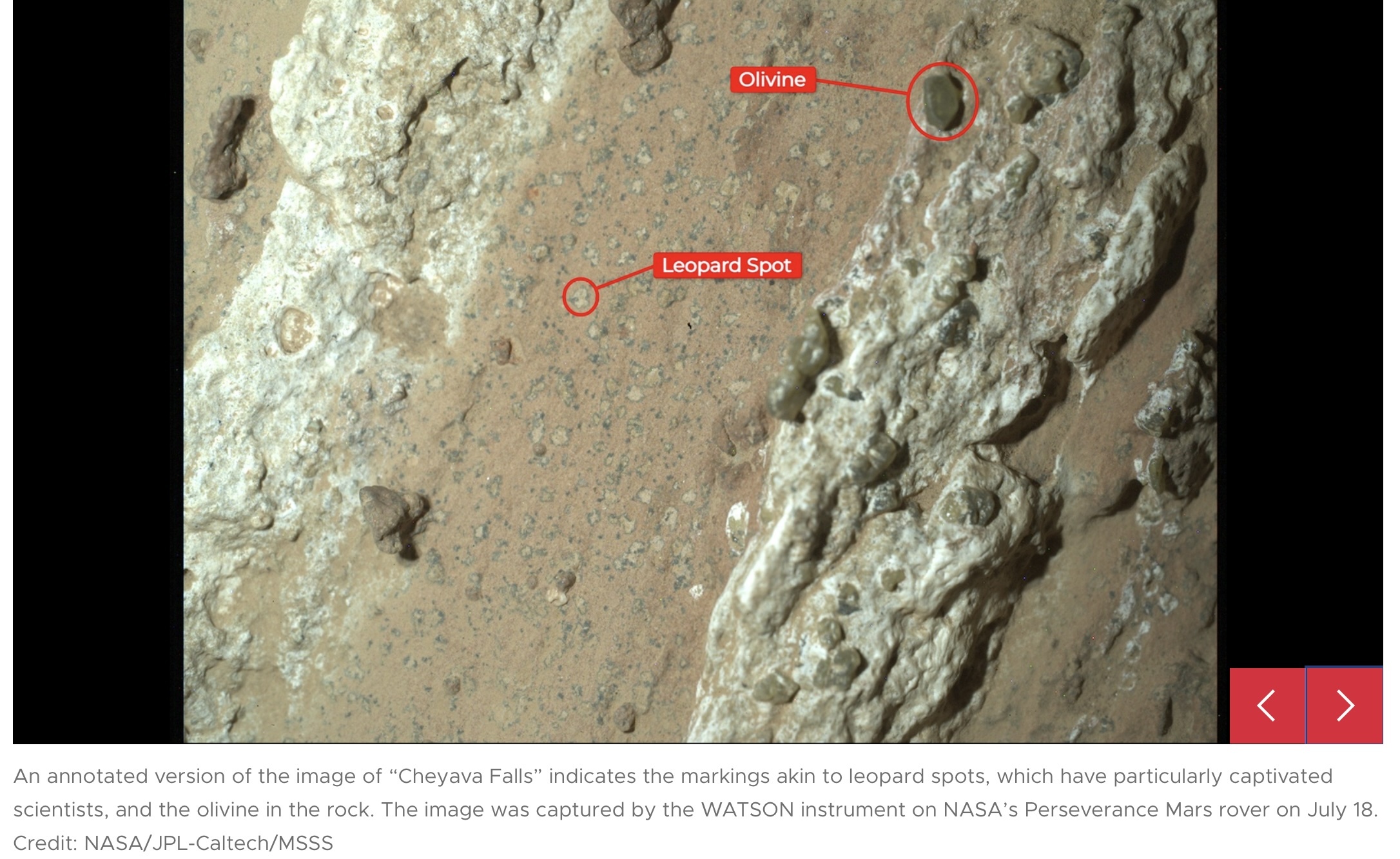
The six-wheeled geologist found a fascinating rock that has some indications it may have hosted microbial life billions of years ago, but further research is needed.
A vein-filled rock is catching the eye of the science team of NASA’s Perseverance rover. Nicknamed “Cheyava Falls” by the team, the arrowhead-shaped rock contains fascinating traits that may bear on the question of whether Mars was home to microscopic life in the distant past.
Analysis by instruments aboard the rover indicates the rock possesses qualities that fit the definition of a possible indicator of ancient life. The rock exhibits chemical signatures and structures that could possibly have been formed by life billions of years ago when the area being explored by the rover contained running water. Other explanations for the observed features are being considered by the science team, and future research steps will be required to determine whether ancient life is a valid explanation.
The rock — the rover’s 22nd rock core sample — was collected on July 21, as the rover explored the northern edge of Neretva Vallis, an ancient river valley measuring a quarter-mile (400 meters) wide that was carved by water rushing into Jezero Crater long ago.
“We have designed the route for Perseverance to ensure that it goes to areas with the potential for interesting scientific samples,” said Nicola Fox, associate administrator, Science Mission Directorate at NASA Headquarters in Washington. “This trip through the Neretva Vallis riverbed paid off as we found something we’ve never seen before, which will give our scientists so much to study.”
Multiple scans of Cheyava Falls by the rover’s SHERLOC (Scanning Habitable Environments with Raman & Luminescence for Organics & Chemicals) instrument indicate it contains organic compounds. While such carbon-based molecules are considered the building blocks of life, they also can be formed by non-biological processes.

NASA’s Perseverance rover used its Mastcam-Z instrument to capture this 360-degree panorama of a region on Mars called “Bright Angel,” where an ancient river flowed billions of years ago. “Cheyava Falls” was discovered in the area slightly right of center, about 361 feet (110 meters) from the rover.
“Cheyava Falls is the most puzzling, complex, and potentially important rock yet investigated by Perseverance,” said Ken Farley, Perseverance project scientist of Caltech in Pasadena. “On the one hand, we have our first compelling detection of organic material, distinctive colorful spots indicative of chemical reactions that microbial life could use as an energy source, and clear evidence that water — necessary for life — once passed through the rock. On the other hand, we have been unable to determine exactly how the rock formed and to what extent nearby rocks may have heated Cheyava Falls and contributed to these features.”
Other details about the rock, which measures 3.2 feet by 2 feet (1 meter by 0.6 meters) and was named after a Grand Canyon waterfall, have intrigued the team, as well.

As shown in this graphic, astrobiologists catalog a seven-step scale, called the CoLD (Confidence of Life Detection) scale, to research whether a sample could indicate life. This “Cheyava Falls” sample is an example of Step One: “Detect possible signal.” Much additional research must be conducted to learn more.
How Rocks Get Their Spots
In its search for signs of ancient microbial life, the Perseverance mission has focused on rocks that may have been created or modified long ago by the presence of water. That’s why the team homed in on Cheyava Falls.
“This is the kind of key observation that SHERLOC was built for — to seek organic matter as it is an essential component of a search for past life,” said SHERLOC’s principal investigator Kevin Hand of NASA’s Jet Propulsion Laboratory in Southern California, which manages the mission.
Running the length of the rock are large white calcium sulfate veins. Between those veins are bands of material whose reddish color suggests the presence of hematite, one of the minerals that gives Mars its distinctive rusty hue.
When Perseverance took a closer look at these red regions, it found dozens of irregularly shaped, millimeter-size off-white splotches, each ringed with black material, akin to leopard spots. Perseverance’s PIXL (Planetary Instrument for X-ray Lithochemistry) instrument has determined these black halos contain both iron and phosphate.
“These spots are a big surprise,” said David Flannery, an astrobiologist and member of the Perseverance science team from the Queensland University of Technology in Australia. “On Earth, these types of features in rocks are often associated with the fossilized record of microbes living in the subsurface.”
Spotting of this type on sedimentary terrestrial rocks can occur when chemical reactions involving hematite turn the rock from red to white. Those reactions can also release iron and phosphate, possibly causing the black halos to form. Reactions of this type can be an energy source for microbes, explaining the association between such features and microbes in a terrestrial setting.
In one scenario the Perseverance science team is considering, Cheyava Falls was initially deposited as mud with organic compounds mixed in that eventually cemented into rock. Later, a second episode of fluid flow penetrated fissures in the rock, enabling mineral deposits that created the large white calcium sulfate veins seen today and resulting in the spots.
Another Puzzle Piece
While both the organic matter and the leopard spots are of great interest, they aren’t the only aspects of the Cheyava Falls rock confounding the science team. They were surprised to find that these veins are filled with millimeter-size crystals of olivine, a mineral that forms from magma. The olivine might be related to rocks that were formed farther up the rim of the river valley and that may have been produced by crystallization of magma.
If so, the team has another question to answer: Could the olivine and sulfate have been introduced to the rock at uninhabitably high temperatures, creating an abiotic chemical reaction that resulted in the leopard spots?
“We have zapped that rock with lasers and X-rays and imaged it literally day and night from just about every angle imaginable,” said Farley. “Scientifically, Perseverance has nothing more to give. To fully understand what really happened in that Martian river valley at Jezero Crater billions of years ago, we’d want to bring the Cheyava Falls sample back to Earth, so it can be studied with the powerful instruments available in laboratories.”
More Mission Information
A key objective of Perseverance’s mission on Mars is astrobiology, including caching samples that may contain signs of ancient microbial life. The rover will characterize the planet’s geology and past climate, to help pave the way for human exploration of the Red Planet and as the first mission to collect and cache Martian rock and regolith.
NASA's Mars Sample Return Program, in cooperation with ESA (European Space Agency), is designed to send spacecraft to Mars to collect these sealed samples from the surface and return them to Earth for in-depth analysis.
The Mars 2020 Perseverance mission is part of NASA’s Moon to Mars exploration approach, which includes Artemis missions to the Moon that will help prepare for human exploration of the Red Planet.
NASA’s Jet Propulsion Laboratory, which is managed for the agency by Caltech, built and manages operations of the Perseverance rover.
Quelle: NASA
----
Update: 16.08.2024
.
NASA’s Perseverance Rover to Begin Long Climb Up Martian Crater Rim
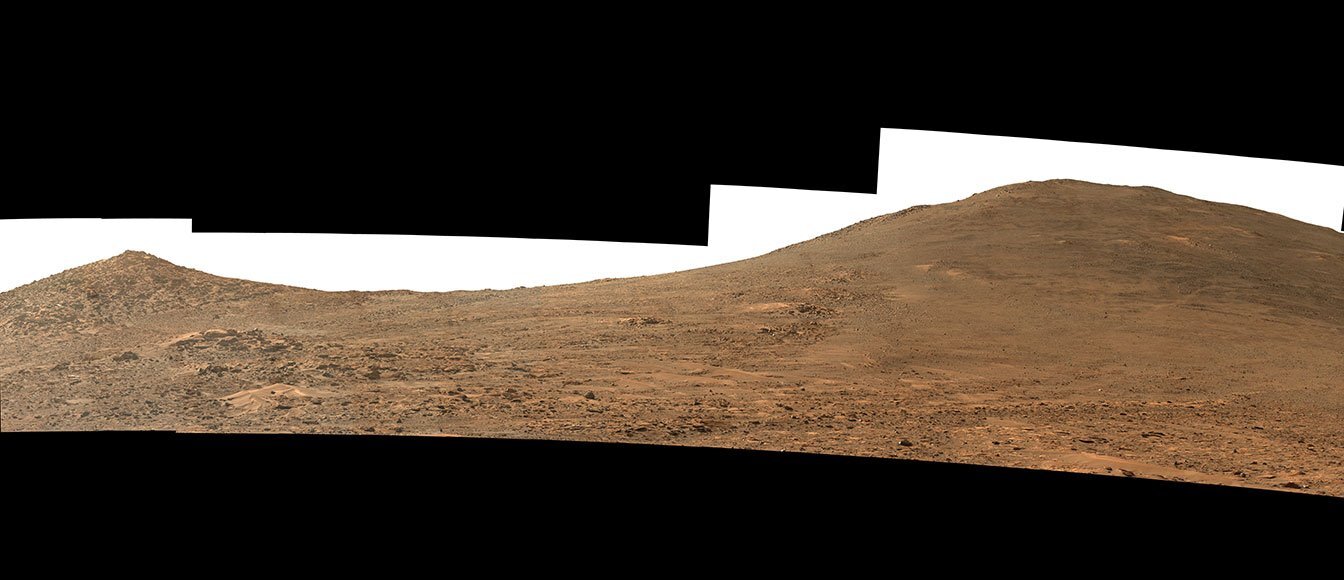
After 2½ years exploring Jezero Crater’s floor and river delta, the rover will ascend to an area where it will search for more discoveries that could rewrite Mars’ history.
NASA’s Perseverance Mars rover will soon begin a monthslong ascent up the western rim of Jezero Crater that is likely to include some of the steepest and most challenging terrain the rover has encountered to date. Scheduled to start the week of Aug. 19, the climb will mark the kickoff of the mission’s new science campaign — its fifth since the rover landed in the crater on Feb. 18, 2021.
“Perseverance has completed four science campaigns, collected 22 rock cores, and traveled over 18 unpaved miles,” said Perseverance project manager Art Thompson of NASA’s Jet Propulsion Laboratory in Southern California. “As we start the Crater Rim Campaign, our rover is in excellent condition, and the team is raring to see what’s on the roof of this place.”

One of the navigation cameras aboard NASA’s Perseverance Mars rover captured this view looking back at the “Bright Angel” area on July 30, the 1,224th Martian day, or sol, of the mission.
Two of the priority regions the science team wants to study at the top of the crater are nicknamed “Pico Turquino” and “Witch Hazel Hill.” Imagery from NASA’s Mars orbiters indicates that Pico Turquino contains ancient fractures that may have been caused by hydrothermal activity in the distant past.
Orbital views of Witch Hazel show layered materials that likely date from a time when Mars had a very different climate than today. Those views have revealed light-toned bedrock similar to what was found at “Bright Angel,” the area where Perseverance recently discovered and sampled the “Cheyava Falls” rock, which exhibits chemical signatures and structures that could possibly have been formed by life billions of years ago when the area contained running water.
It's Sedimentary
During the river delta exploration phase of the mission, the rover collected the only sedimentary rock ever sampled from a planet other than Earth. Sedimentary rocks are important because they form when particles of various sizes are transported by water and deposited into a standing body of water; on Earth, liquid water is one of the most important requirements for life as we know it.

This map shows the route NASA’s Perseverance Mars rover will take (in blue) as it climbs the western rim of Jezero Crater, first reaching “Dox Castle,” then investigating the “Pico Turquino” area before approaching “Witch Hazel Hill.”
A study published Wednesday, Aug. 14, in AGU Advances chronicles the 10 rock cores gathered from sedimentary rocks in an ancient Martian delta, a fan-shaped collection of rocks and sediment that formed billions of years ago at the convergence of a river and a crater lake.
The core samples collected at the fan front are the oldest, whereas the rocks cored at the fan top are likely the youngest, produced when flowing water deposited sediment in the western fan.
“Among these rock cores are likely the oldest materials sampled from any known environment that was potentially habitable,” said Tanja Bosak, a geobiologist at the Massachusetts Institute of Technology in Cambridge and member of Perseverance’s science team. “When we bring them back to Earth, they can tell us so much about when, why, and for how long Mars contained liquid water and whether some organic, prebiotic, and potentially even biological evolution may have taken place on that planet.”
Onward to the Crater Rim
As scientifically intriguing as the samples have been so far, the mission expects many more discoveries to come.
“Our samples are already an incredibly scientifically compelling collection, but the crater rim promises to provide even more samples that will have significant implications for our understanding of Martian geologic history,” said Eleni Ravanis, a University of Hawaiì at Mānoa scientist on Perseverance’s Mastcam-Z instrument team and one of the Crater Rim Campaign science leads. “This is because we expect to investigate rocks from the most ancient crust of Mars. These rocks formed from a wealth of different processes, and some represent potentially habitable ancient environments that have never been examined up close before.”
Reaching the top of the crater won’t be easy. To get there, Perseverance will rely on its auto-navigation capabilities as it follows a route that rover planners designed to minimize hazards while still giving the science team plenty to investigate. Encountering slopes of up to 23 degrees on the journey (rover drivers avoid terrain that would tilt Perseverance more than 30 degrees), the rover will have gained about 1,000 feet (300 meters) in elevation by the time it summits the crater’s rim at a location the science team has dubbed “Aurora Park.”
Then, perched hundreds of meters above a crater floor stretching 28 miles (45 kilometers) across, Perseverance can begin the next leg of its adventure.
Quelle: NASA



